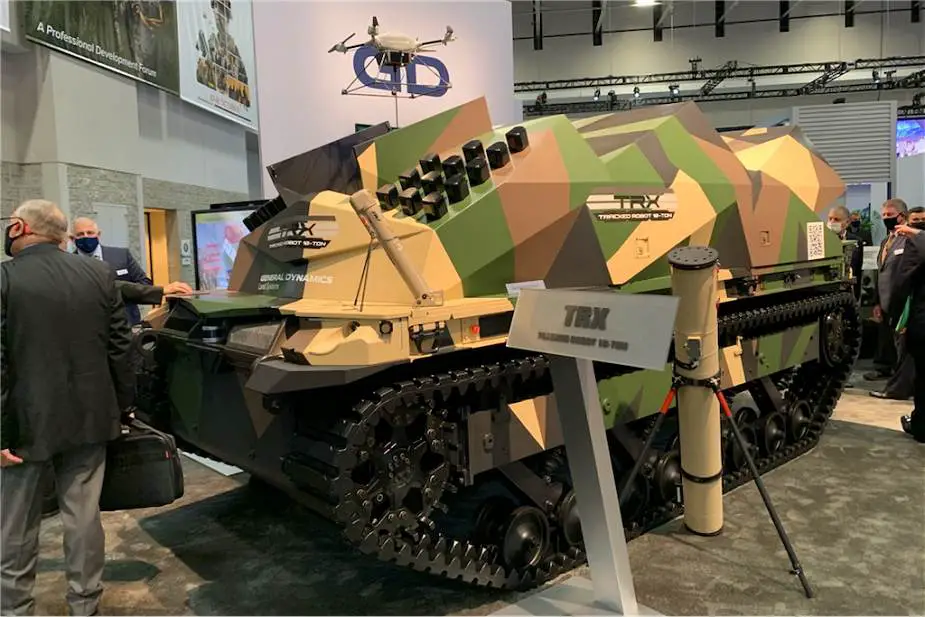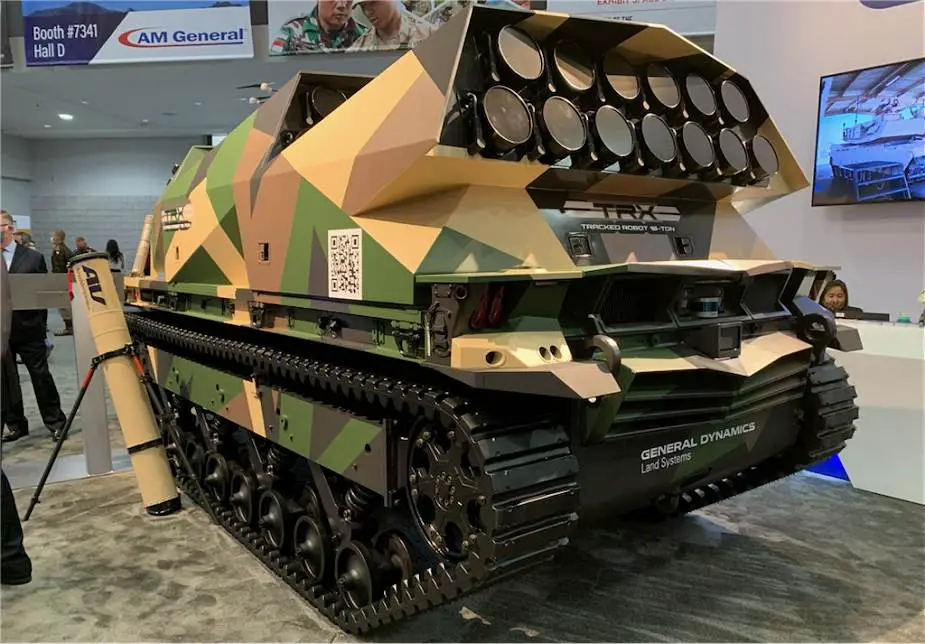General Dynamics has developed the TRX multirole combat robotic platform for US Army RCV program
American company General Dynamics Land Systems (GDLS) has developed the ton-10 class robot TRX for the US Army’s RCV-Medium (RCV-M) Robotic Combat Vehicle program. TRX features innovative thinking, ranging from its AI-enhanced design to advanced, lightweight materials and a hybrid-electric propulsion system.
Follow Army Recognition on Google News at this link

General Dynamics Land Systems displays during AUSA 2021 the latest variant of its TRX Robotic Combat Vehicle fitted with Loitering Missiles System and drone. (Picture source Twitter accountAeroVironment )
The RCV (Robotic Combat Vehicle) is a vehicle being developed as part of the Army’s Next Generation Combat Vehicle (NGCV) family of vehicles, which also includes the Optionally Manned Fighting Vehicle (OMFV), Mobile Protected Firepower (MPF), and the Armored Multi-Purpose Vehicle (AMPV). As part of the NGCV program, the U.S. Army plans to develop three RCV variants: Light, Medium, and Heavy.
The RCV-M (Robotic Combat Vehicle - Medium) is to weigh between 10 and 20 tons, with dimensions (length, width, height) of no more than 230 x 107 x 94 inches. In terms of transportability, a single RCV-M is to be transported by a C-130 transport aircraft. The RCV-M is to have increased onboard lethality to defeat light-to medium-armored threats. The RCV-M is considered “durable” by the U.S. Army, meaning the Army would like the RCV-M to be more survivable than the RCV-L RCV-Light).
The TRX platform is built on the success of the Multi-Utility Tactical Transport (MUTT), a lighter robotic vehicle developed by GDLS (General Dynamics Land Systems), which was selected by the U.S. Army for the Small Multipurpose Equipment Transport (S-MET) program.
The TRX is based on a multirole tracked chassis platform weighing 10,000 kg with a payload capacity of 450 kg and a flat deck to accommodate any type of mission equipment package. The robot is powered by a hybrid power plant based on a diesel engine, batteries, and electric motors. Its characteristics are sufficient to ensure high mobility on the ground, as well as to power the platform systems and payload.
The TRX is positioned to provide superior performance as enabling technology in a myriad of critical battlefield roles, including direct and indirect fire, autonomous resupply, complex obstacle breaching, counter-unmanned aerial systems (C-UAS), electronic warfare (EW), reconnaissance, and other battlefield missions.

At AUSA 2021, the TRX of GDLS was equipped with AeroVironment Switchblade 300 and 600 Loitering Missiles Systems. (Picture source Twitter account AeroVironment)
In October 2021 during AUSA, the Association of United States Army exhibition that was held in Washington D.C., General Dynamics Land Systems has displayed a concept vehicle based on the TRX platform featuring integrated AeroVironment Switchblade 300 and 600 Loitering Missiles Systems. The vehicle was fitted with two banks of 13 launch tubes for Switchblade 600 drones, as well as two other rows of 12 tubes capable of launching smaller Switchblade 300s mounted at the rear of the robot. The TRX displayed at AUSA 2021, was also fitted with a storage area located at the front of the vehicle able to accommodate one UAV (Unmanned Aerial Vehicle) that can be used to conduct reconnaissance and observation missions.
Loitering ammunition also named kamikaze drone, is a weapon system category in which the ammunition loiters around the target area for some time, searches for targets, and attacks once a target is located. Loitering munitions enable faster reaction times against concealed or hidden targets that emerge for short periods without placing high-value platforms close to the target area, and also allow more selective targeting as the actual attack mission can be aborted.
The Switchblade 600 represents the next generation of extended-range loitering missiles, delivering unprecedented RSTA support and featuring high-precision optics, over 40 minutes of loitering endurance, and an anti-armor warhead for engaging larger, hardened targets at greater distances. Equipped with class-leading, high-resolution EO/IR gimbaled sensors and advanced precision flight control, Switchblade 600 empowers the warfighter with quick and easy deployment via tube-launch, and the capability to fly, track and engage non-line-of-sight targets and light-armored vehicles at a maximum range of 90 km with precision lethal effects without the need for external ISR or fires assets.
The Switchblade 300 is a portable loitering ammunition that can be used against beyond-line-of-sight targets with a maximum range of 10 km. Back-packable and rapidly deployable from air, sea or ground platforms, Switchblade 300 features increased lethality, reach and precision strike capabilities with low collateral effects. Remotely piloted or flown autonomously, Switchblade can provide real-time GPS coordinates and video for information gathering, targeting, or feature/object recognition. The vehicle's small size and quiet electric motor make it difficult to detect, recognize, and track, even at close range.


























